Royalty in Fragrance & Jewelry:
A Regal Ode to 10 Iconic Women Leaders Through Time
Dear Admirers of Timeless Royal Elegance,
Embark with us on a journey transcending time, where the timeless elegance of queens and czarinas converges harmoniously with the opulent fragrances of our exclusive line of jeweled perfumes. This narrative unfolds to reveal unparalleled sophistication – a journey through history, scent, and regality.
In this regal symphony of fragrance and jewelry, we pay homage to the timeless elegance, wisdom, and grace of iconic women leaders. Let the scents of history and the sparkle of jewels transport you to eras where queens and czarinas reigned supreme, leaving an indelible mark on the world of opulence and aromatic allure. Elevate your senses, for you are deserving of nothing less than the majestic legacy of regal women through time.
1. CLEOPATRA: TIMELESS RADIANCE IN JEWELS AND AROMAS
Her favourite perfume: Mendesian Perfume
Her favourite jewel: Serpent Diadem
Cleopatra VII, the last Pharaoh of Egypt, reigned with unparalleled grace and intellect. Her Serpent Diadem, a crown adorned with cobras, symbolized divine power. Much like her mesmerizing presence, the fragrances of her court, redolent with the essence of myrrh and frankincense, evoke the magic of ancient Egypt.
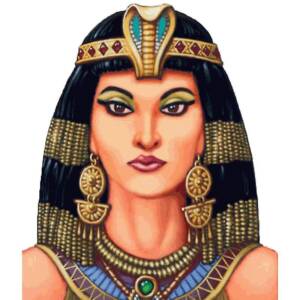
Image source: Fruugo UK
Cleopatra’s legacy transcends time, an eternal radiance encapsulated in both regal jewels and aromatic whispers. In Cleopatra’s time, Egypt had a longstanding tradition of producing incense and perfumes, which it exported across the ancient world. The earliest known recipe, for a fragrance known in Greece as kyphi, dates to the construction of the very first pyramids. While modern perfumes are based on alcohol, kyphi was made using animal fat and vegetable oil. These were burned alongside resins, roots, and berries, creating a smoke that the Egyptians used to scent their homes as well as their clothing.
The unique fragrance Cleopatra is believed to have worn came from Mendes, a prosperous settlement in the Nile Delta that played an integral part in the trade of spices from India, Africa, and Arabia.
Both the Roman philosopher Pliny the Elder and the Greek physician Dioscorides acknowledged Mendesian perfume as the finest of its kind — a classical equivalent to “Chanel No. 5,” in the words of archaeologists who sought to piece together its long-lost recipe from different historical texts. Since there are no surviving Egyptian sources that contain a complete recipe for Mendesian perfume, archaeologists had to turn to Greco-Roman accounts to fill in the gaps. These accounts agree on four main ingredients. In addition to resin and myrrh, the perfume also contained cassia, a less potent kind of cinnamon plant, and balanos oil, a semi-drying oil produced from the seeds of Balanites aegyptiaca (Egyptian balsam), a tree native to northern Africa and the Middle East.
2. QUEEN ELIZABETH I: THE DARNLEY PORTRAIT AND PEARLESCENT POWER
Her favourite perfume: Musky Rose
Her favourite jewel: Pearls
Queen Elizabeth I, the Virgin Queen, graced the Elizabethan era with her formidable reign. The Darnley Portrait immortalizes her in a gown adorned with pearls, emblematic of her prosperity and power. Pearls, the epitome of sophistication, mirrored Elizabeth’s regal authority. As we delve into the fragrant tapestry of her court, we encounter scents that echo the opulence and poise of a queen who defined an era.
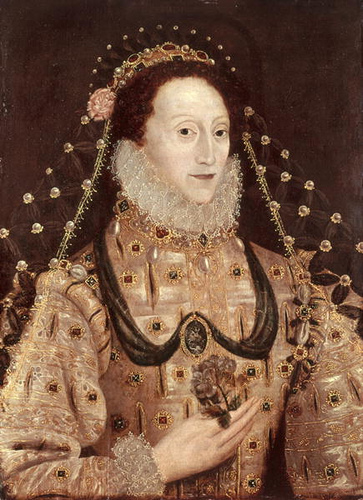
Image Source: The Perfume Society Org
In the enchanting Elizabethan era, the revelation of exotic spices marked a splendid moment, allowing individuals to envelop themselves in the aromatic essence of success and opulence. Locked chests guarded these precious perfumes, transforming the wearer into a fragrant spectacle.
As explorers like Vasco de Gama, Magellan, and Columbus traversed the globe, they bestowed Europe with an unprecedented treasure trove of scented materials, including vanilla, pepper, Peru balsam, cardamom, sandalwood, clove, and cocoa. These ingredients, initially sought for culinary purposes, seamlessly found their way into the art of perfumery.
The flourishing trade with the East introduced not only exotic spices but also living plants, such as orange trees with their romantic blossoms, jasmine, and roses. Simultaneously, the expertise of distillers evolved, enabling the extraction of essential oils from an array of aromatic sources like frankincense, pine, cedarwood, cardamom, fennel, nutmeg, agarwood (now known as ‘oud’), sweet flag, and anise.
While perfumes ostensibly served to mask unpleasant odors, the popularity of lingering scents like tuberose, jasmine, and musk soared. Queen Elizabeth I beckoned Venetian traders to Southampton, embracing the allure of musk and rose-scented pomanders and sachets. In the heart of households, fragrances were crafted from recipes found alongside culinary and medicinal secrets, contributing to the aromatic tapestry of this illustrious era.
3. EMPRESS JOSEPHINE: DIAMONDS AND THE SYMPHONY OF ROMANCE
Her favourite perfume: Violet flowers
Her favourite jewel: Hortensia Brooch with Diamonds and Rubies
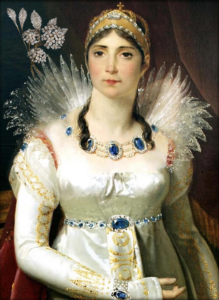
Image source: History.info
Empress Josephine, renowned as the wife of Napoleon Bonaparte, graced the era with her elegance and romantic aura. The Hortensia Bow Brooch, adorned with diamonds and sapphires, emerged as a symbol of her profound influence on French fashion, leaving an indelible mark on the pages of history.
The fragrances that enveloped her imperial court were a symphony of blossoming flowers, capturing the essence of Josephine’s love for nature and romance. Her story is eternally woven into the scintillating sparkle of diamonds and the aromatic melodies of love.
Empress Josephine, captivated by the delicate allure of violets, ushered in a new era of perfume trends during the 19th Century. This bouquet, crafted with the essence of dew-kissed spring violets heightened by a subtle infusion of rose, gracefully unfolds over a mossy foundation of cedarwood and oak moss. The potency of her chosen scent was so profound that its echoes permeated the very walls of her boudoir, leaving an enduring olfactory legacy. Josephine’s devotion extended beyond fragrance as she adorned herself in regal violet hues. Radiating elegance, she draped herself in violet silk gowns, delicate shawls, and silk slippers, complemented by the renowned Amethyst Parure gracing her neck, arms, and ears.
4. CZARINA CATHERINE THE GREAT: IMPERIAL GRANDEUR IN JEWELS
Her favourite perfume: Natural floral extracts, spices, and resins
Her favourite jewel: The Great Imperial Crown
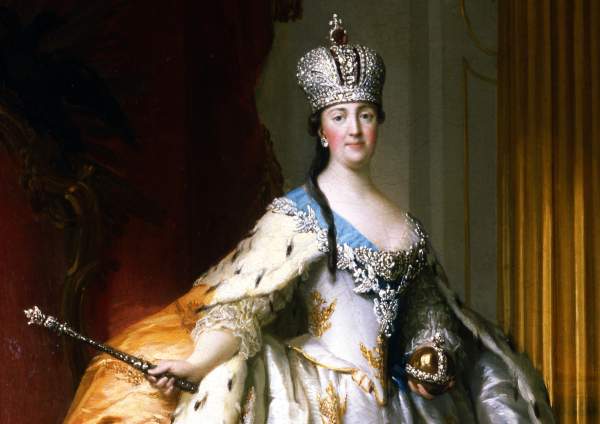
Image source: Wikimedia
In the 18th century, perfumes were often composed of natural ingredients such as floral extracts, spices, and resins. Popular scents included blends of rose, lavender, jasmine, citrus, and various herbs. Musk, ambergris, and other animal-derived ingredients were also commonly used as fixatives. The use of perfume during this time was not only for personal fragrance but also to mask unpleasant odors, as personal hygiene practices varied.
Perfumes were often created in the form of oils, pomades, or solid waxes, as the modern alcohol-based perfumes we are familiar with today were not yet prevalent. These fragrances were applied to the skin, clothing, or carried in small, ornate containers.
It’s important to note that the availability and popularity of specific scents could vary, and the art of perfumery was still evolving during this period. Additionally, the social elite, including royalty, might have had access to more sophisticated and exclusive perfumes. Specific details about popular perfumes in Russia during Catherine the Great’s reign may not be extensively documented.
5. QUEEN VICTORIA: DIAMONDS, THE KOH-I-NOOR, AND VICTORIAN LEGACY
Her favourite perfume: Creed ‘Fleurs de Bulgarie’
Her favourite jewel: Diamonds, The Koh-i-Noor Diamond
In the grand tapestry of Queen Victoria’s reign, a period synonymous with Victorian elegance and societal progress, one gem stood out among the dazzling treasures – the Koh-i-Noor Diamond. This exquisite diadem, adorned with sapphires and diamonds, was not just a piece of regal jewelry but a symbol of imperial majesty. Prince Albert, deeply involved in the adornment of his queen, meticulously curated suites and parures, showcasing his devotion and keen eye for detail.
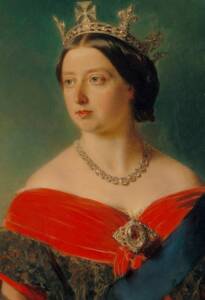
Image source: Wikipedia
The Koh-i-Noor Diamond, once recut to amplify its brilliance, seamlessly integrated into the resplendent regalia of Queen Victoria, adding an extra layer of majesty to her illustrious reign. Beyond its role in her crown, this legendary diamond embarked on a fascinating journey, passing through the hands of various royalties and experiencing two intriguing losses. The first chapter unfolded when Emperor Humayun unintentionally left it on a riverbank in Iran, and the second episode occurred when John Lawrence, a senior British civil servant, momentarily misplaced this invaluable gem.
The fragrances that wafted through Queen Victoria’s court not only encapsulated the olfactory preferences of a transformative era but also mirrored the evolving tastes of a period marked by sophistication and progress. In the intertwining realms of diamonds and aromas, Queen Victoria’s legacy emerges as a timeless testament to the refined elegance that defined the Victorian age. Despite her disdain for overly lavish scents, Queen Victoria’s unique perspective associated excessive fragrance, cosmetics, and makeup with questionable morals. Even as makeup made a subtle return later in the Victorian era, it embraced a natural, healthy aesthetic, steering clear of the perceived decadence of fully made-up faces deemed sinful.
Victoria held a special affinity for the prestigious British perfume house, Creed. In 1845, Creed bestowed upon her the enchanting ‘Fleurs de Bulgarie,’ a captivating composition of Bulgarian rose, musk, ambergris, and bergamot. This aromatic symphony accompanied her throughout her illustrious reign, and its modern iteration remains a perennial bestseller. As the Queen navigated the intricacies of her reign, ‘Fleurs de Bulgarie’ lingered in the air, leaving an indelible mark on the corridors of power. Its enduring popularity, evidenced by its contemporary allure, attests to the timeless elegance encapsulated in this fragrant masterpiece. Today, the modern iteration of this aromatic symphony stands as a testament to Victoria’s enduring influence on the world of perfumery, where her discerning nose shaped a legacy of sophistication and grace.
6. QUEEN ELIZABETH II: MODERN MONARCHY IN THE GLEAM OF AQUAMARINES
Her favourite perfume: Guerlain ‘L’Heure Bleue’, Chanel ‘No.5’, White Rose by Floris
Her favourite jewel: The Brazilian Aquamarine Set
Queen Elizabeth II, the longest-reigning British monarch, loved wearing colorful clothes and jewelry, especially light blue. Her reign, characterized by adaptability and resilience, finds its olfactory counterpart in the scents that surround the modern monarchy. In the gleam of diamonds and the fragrant echoes of her era, Queen Elizabeth II stands as a contemporary symbol of enduring grace.
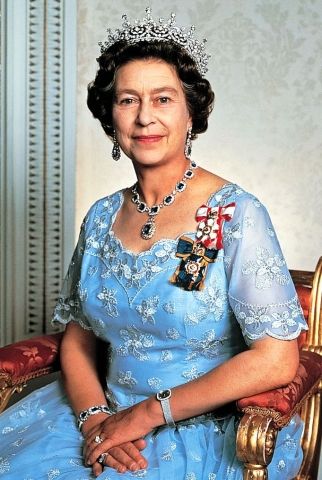
Image source: Pintrest
One of her most loved jewelry sets was The Brazilian Aquamarine Parure. In a regal gesture from the esteemed president of Brazil, Queen Elizabeth was bestowed upon a splendid coronation gift—a resplendent ensemble comprising a pair of earrings and a necklace adorned with mesmerizing aquamarines and diamonds. Subsequently, Her Majesty, in her discerning elegance, entrusted the renowned House of Garrard to craft a complementary tiara, thereby augmenting the radiant allure of her royal regalia. In the passage of time, additional treasures of aquamarines and diamonds from Brazil graced the Queen’s collection, including a bracelet, a brooch, and a delicately fashioned hair ornament, each a testament to the enduring bond between nations and the transcendent beauty of diplomatic gestures.
The queen adored two fragrances: L’Heure Bleue by Guerlain and White Rose by Floris. L’Heure Bleue by Guerlain (The Blue Hour in English), an iconic fragrance celebrated for its opulent tenderness and evocative romantic essence, weaves an olfactory tapestry that transports one to the enchanting realm of the bluish dusk, where the air is imbued with the palpable anticipation of nightfall.
This legendary perfume unfolds its aromatic symphony with an inaugural dance of anise and bergamot, an overture that tantalizes the senses and sets the stage for the blossoming heart notes. Here, a bouquet of florals, including the ethereal essences of iris, violet, jasmine, and rose, intertwines delicately, each note contributing to the fragrance’s harmonious crescendo.
As the fragrance matures, its base notes emerge, a sublime fusion of powdery and woody elements that bestows upon L’Heure Bleue its timeless and refined allure. The result is a fragrance of undeniable elegance, characterized by a powdery softness and an unmistakably feminine floral richness, rendering it a masterpiece that stands the test of time. L’Heure Bleue is not merely a scent; it is a poetic journey through the hues of evening, capturing the essence of fleeting moments and the enduring allure of sophistication.”
7. GRACE KELLY: HOLLYWOOD ROYALTY AND THE CARTIER DIAMOND RING
Her favourite perfume: Creed ‘Fleurissimo’
Her favourite jewel: Cartier Diamond Engagement Ring
Grace Kelly’s journey from Hollywood to Monaco’s royalty is crowned by the iconic Cartier diamond engagement ring, a symbol of timeless romance that encapsulates her elegance and enduring love story. The fragrances of her court blend the sophistication of Hollywood royalty with the timeless allure of European nobility. Grace Kelly’s legacy lives on in the sparkle of diamonds and the lingering scents of romance.
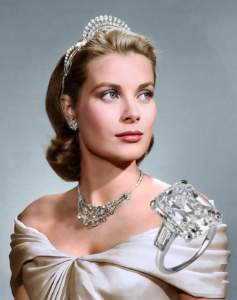
Image source: gracie-bird.tumblr.com
Princess Grace Kelly’s iconic engagement ring, a gift from Prince Rainier III of Monaco in 1955, remains a symbol of regal romance. The timeless design features a 10.47-carat emerald-cut diamond in platinum, flanked by two baguette-cut diamonds. Originally part of a 1920s French tiara, the diamond’s journey from tiara to bracelet culminated in the iconic engagement ring.
Presented during a private dinner at the Prince’s Palace in Monaco, the ring’s stunning design and the romantic proposal became an instant sensation, gracing newspapers worldwide. Princess Grace adorned the ring in films and public appearances, solidifying its legacy. Passed down to Princess Caroline and later to Charlotte Casiraghi, the ring continues to inspire brides such as Paris Hilton and Jennifer Lopez, as well as designers globally, epitomizing timeless elegance and enduring love.
Grace Kelly, renowned for her timeless elegance, chose a fragrance from Creed, a house with a regal legacy dating back to 1780, for her marriage to Prince Rainier of Monaco. In a gesture of true aristocratic romance, Prince Rainier commissioned ‘Fleurissimo’ as a bespoke wedding day gift for his beloved bride.
This olfactory masterpiece unfolds into a refined bouquet, featuring the enchanting notes of tuberose, violet, iris, and Bulgarian rose. Each element harmonizes to create a fragrance that transcends mere scent, capturing the essence of nobility and sophistication. Grace Kelly’s selection of Creed’s Fleurissimo not only added a touch of opulence to her wedding day but also solidified the fragrance as an emblem of enduring love and regal refinement in the world of aristocratic unions. Creed’s timeless appeal to royalty is rooted in its steadfast dedication to natural ingredients, avoiding synthetics. Over their remarkable 255-year history—a significant accomplishment in itself—not a single synthetic or manufactured component has been introduced into any of their 72 fragrances.
8. JACKIE KENNEDY ONASSIS: THE ENDURING AURA OF A TIMELESS PEARL
Her favourite perfume: Jean Patou Paris ‘Joy’, ‘Krigler Lovely Patchouli 55’
Her favourite jewel: A Three-Strand Pearl Necklace, Cartier Tank Watch
Jackueline Kennedy, the epitome of finesse and style, left an indelible mark not only in the world of fashion but also in the realm of fragrance and jewelry. Known for her impeccable taste, she embraced the allure of exquisite perfumes, weaving an olfactory legacy that mirrored her enduring elegance.

Jackie Kennedy entered the public spotlight as the elegant First Lady of the United States alongside President John F. Kennedy. Her refined taste and fashion sensibilities made her a style icon of the 1960s. After the tragic assassination of President Kennedy in 1963, Jackie continued to leave her mark as a prominent figure, marrying Greek shipping magnate Aristotle Onassis and later working in publishing and preservation efforts until her passing in 1994.
In the world of jewelry, Jackie Kennedy adorned herself with exquisite pieces, most notably the resplendent Cartier Tank Watch. This sophisticated timepiece, bestowed upon her by her brother-in-law Prince Stanislaw Radziwill, transcended mere functionality. It became a symbol not only of the ticking hands of time but also of the enduring allure of timeless accessories. Jackie’s penchant for such treasures wove seamlessly into the fabric of her fashion narrative, revealing a woman who effortlessly understood the art of harmonizing fragrance and jewelry to create a timeless symphony of style.
Among her most iconic preferences, pearls held a special place in Jackie’s heart. Her enduring love affair with pearls is encapsulated in her most replicated look – a three-strand pearl necklace. Photographs abound, capturing her innate appreciation for the simple grace emanating from these pearl necklaces, showcasing Jackie’s unparalleled mastery in the delicate art of timeless elegance.
Jackie Kennedy, with her discerning taste in fragrances, adorned herself with various scents over the years, among them Krigler Lovely Patchouli 55—a captivating fusion of spicy patchouli, bergamot, and leather. However, her enduring favorite was the timeless Joy by Jean Patou, renowned as the world’s most luxurious and expensive perfume. This opulent floral composition, blending coriander, osmanthus flower, and patchouli, beckons wearers to embody both delicacy and spontaneity. Throughout the 1970s, Jackie embraced the bold and enduring essence of Joy, creating an olfactory legacy that remains a rare find in contemporary times.
9. PRINCESS DIANA: ELEGANCE AND HUMANITARIAN GRACE
Her favourite perfume: Dior ‘Diorissimo’, Penhaligon’s ‘Bluebell’, Annick Goutal ‘Passion’
Her favourite jewel: Ceylon Sapphire and Diamond Engagement Ring
Princess Diana, the People’s Princess, graced the world with her elegance and humanitarian efforts. Her sapphire and diamond engagement ring, now passed down to the Duchess of Cambridge, remains an iconic symbol of timeless style. The fragrances that surrounded Princess Diana reflected her grace and compassion. In jewels and scents, she remains an eternal emblem of both regal charm and philanthropy.
 Princess Diana’s iconic sapphire ring, now gracing Kate Middleton’s hand, narrates a singular story. Unlike the customary bespoke royal engagement rings, Diana’s selection from Garrard’s 1981 catalog stirred some debate within the royal echelons. The 12-carat oval Ceylon sapphire, purchased by Charles for $60,000, now transcends its monetary value, standing as an irreplaceable emblem of cultural and emotional richness. Unconventionally sourced yet undeniably timeless, the ring draws inspiration from a sapphire brooch presented by Prince Albert to Queen Victoria—a poignant detail, as she wore it as her “something blue” at her wedding. Prince Charles, influenced by this familial connection, chose the same design for Diana.
Princess Diana’s iconic sapphire ring, now gracing Kate Middleton’s hand, narrates a singular story. Unlike the customary bespoke royal engagement rings, Diana’s selection from Garrard’s 1981 catalog stirred some debate within the royal echelons. The 12-carat oval Ceylon sapphire, purchased by Charles for $60,000, now transcends its monetary value, standing as an irreplaceable emblem of cultural and emotional richness. Unconventionally sourced yet undeniably timeless, the ring draws inspiration from a sapphire brooch presented by Prince Albert to Queen Victoria—a poignant detail, as she wore it as her “something blue” at her wedding. Prince Charles, influenced by this familial connection, chose the same design for Diana.
Her favourite perfume: Guerlain ‘Samsara’
Her favourite jewel: Boucheron Bracelet Tiara, Queen Alia’s Cartier Tiara, Emerald Ivy Tiara
The fragrances that envelop Queen Rania’s court encapsulate the essence of modern sophistication and global consciousness. In stunning tiaras and aromatic whispers, Queen Rania stands as a contemporary leader with a profound impact.
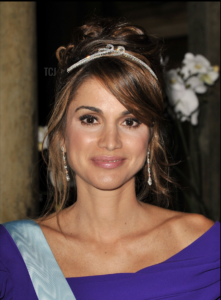
image source: Pinterest
Queen Rania of Jordan is a visionary leader in the Middle East, renowned for her advocacy in education and community empowerment. Her activities encompass issues such as education, health, youth, and the environment, among others. Her Majesty has been particularly vocal about the importance of cross-cultural and interfaith dialogue towards greater understanding, tolerance, and acceptance across the world. This commitment to progress is seamlessly reflected in her public persona, where she effortlessly marries modernity with elegance. Her fashion choices, marked by contemporary simplicity, are elevated by exquisite jewelry, embodying sophistication with delicate gem-set designs, scrolls, swirls, and occasional Arabesque motifs.
For grand occasions, Queen Rania embraces glamour with an innate sense of regality, particularly through her affinity for tiaras. She loves tiaras, and we have picked out some of her favorites. Despite not owning a vast collection of tiaras, she occasionally borrows them from grandeur designer brands like Boucheron or Cartier.
Queen Rania frequently wears the Boucheron Bracelet Tiara, a sleek and versatile diamond bandeau that seamlessly transforms into a bracelet. Since at least 2008, she has adorned this elegant piece at state dinners, the wedding of Crown Princess Victoria and Prince Daniel of Sweden in 2010, and the tenth-anniversary celebration of her husband’s coronation in 2009. The tiara’s timeless allure and adaptability make it a cherished choice for the queen’s regal engagements.
Crafted by Cartier in the 1970s for Queen Alia of Jordan, the Cartier Tiara radiates regal splendor and timeless elegance. Inherited by her daughter, Princess Haya, after Queen Alia’s passing in 1977, the tiara has been graciously loaned to Queen Rania on select occasions. Notably, Queen Rania adorned this illustrious piece during her husband’s coronation in June 1999 and showcased its undeniable grace at a gala dinner in Madrid during a state visit to Spain in October 1999.
According to Spanish media reports, the Jordanian queen’s preferred fragrance is Guerlain’s iconic Samsara, a creation by Jean-Paul Guerlain from 1989. This amber woody fragrance envelops with jasmine and ylang-ylang, accentuated by the radiant warmth of sandalwood. With top notes of bergamot, lemon, ylang-ylang, peach, and green notes, and heart notes featuring jasmine, iris, narcissus, violet, and rose, it concludes with base notes of sandalwood, vanilla, tonka bean, amber, and musk.
Samsara, signifying “eternal rebirth” in Sanskrit, embodies harmony and absolute, sacred love. Jean-Paul Guerlain, inspired by a woman named Décia de Pauw, a horsewoman he instantly fell in love with, created this fragrance as a pure expression of her unique sensuality and intimacy.
Conclusion
As we conclude this enchanting journey through the annals of royalty, let us linger in the intoxicating aura of beautiful jewels and captivating perfumes. Each queen and czarina, from Cleopatra’s divine diadem to Queen Rania’s contemporary elegance, has left an indelible mark on history and fashion. Tzarḯnah, and our exclusive lines of jeweled perfumes, pay homage to these iconic women leaders, harmonizing the opulence of regal jewels with the allure of timeless fragrances.
In reflecting upon the delicate yet powerful essence of these remarkable women, we find that almost all of them held a penchant for floral scents. If you aspire to feel like a queen, empress, or czarina in your own life—gentle yet powerful—indulge in the captivating allure of our newest green floral scent, ‘The Diamond Garden’ by Tzarḯnah. Immerse yourself in the scintillating sparkle of diamonds, the sophistication of pearls, and the essence of blooming flowers, for you, dear admirers, are deserving of nothing less than the majestic legacy of regal women through time. Elevate your senses and embrace the enchantment of timeless royal elegance.
Discover our first perfume collection here
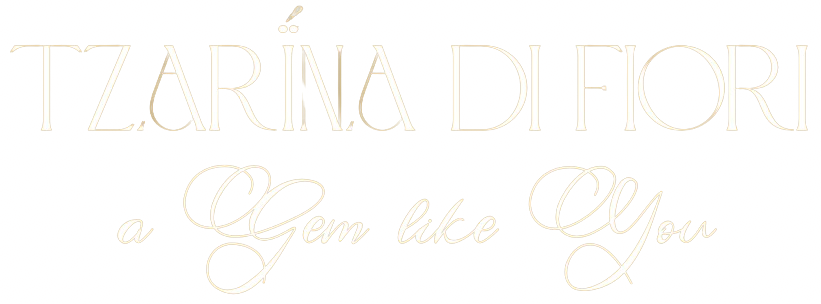
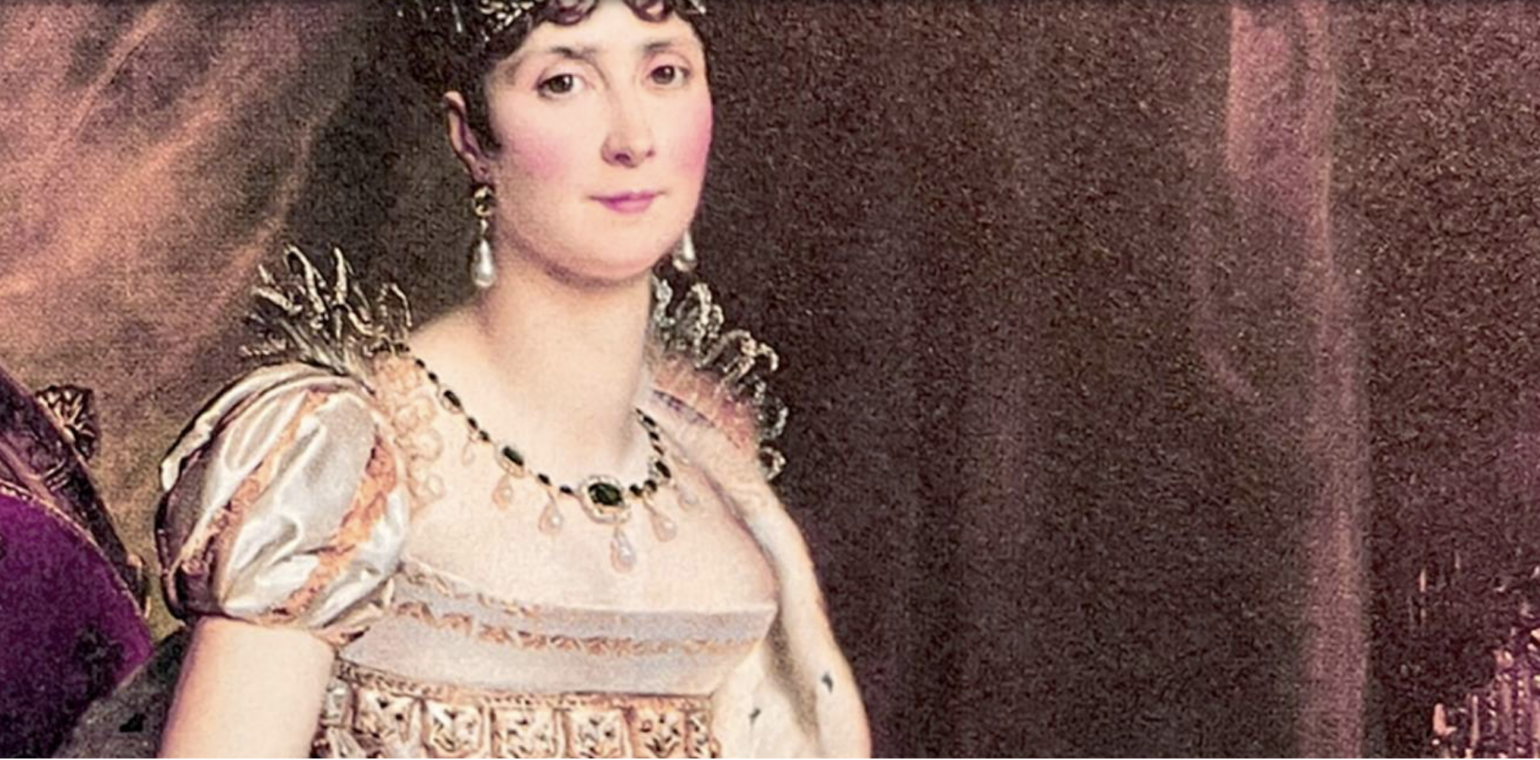
Add Comment